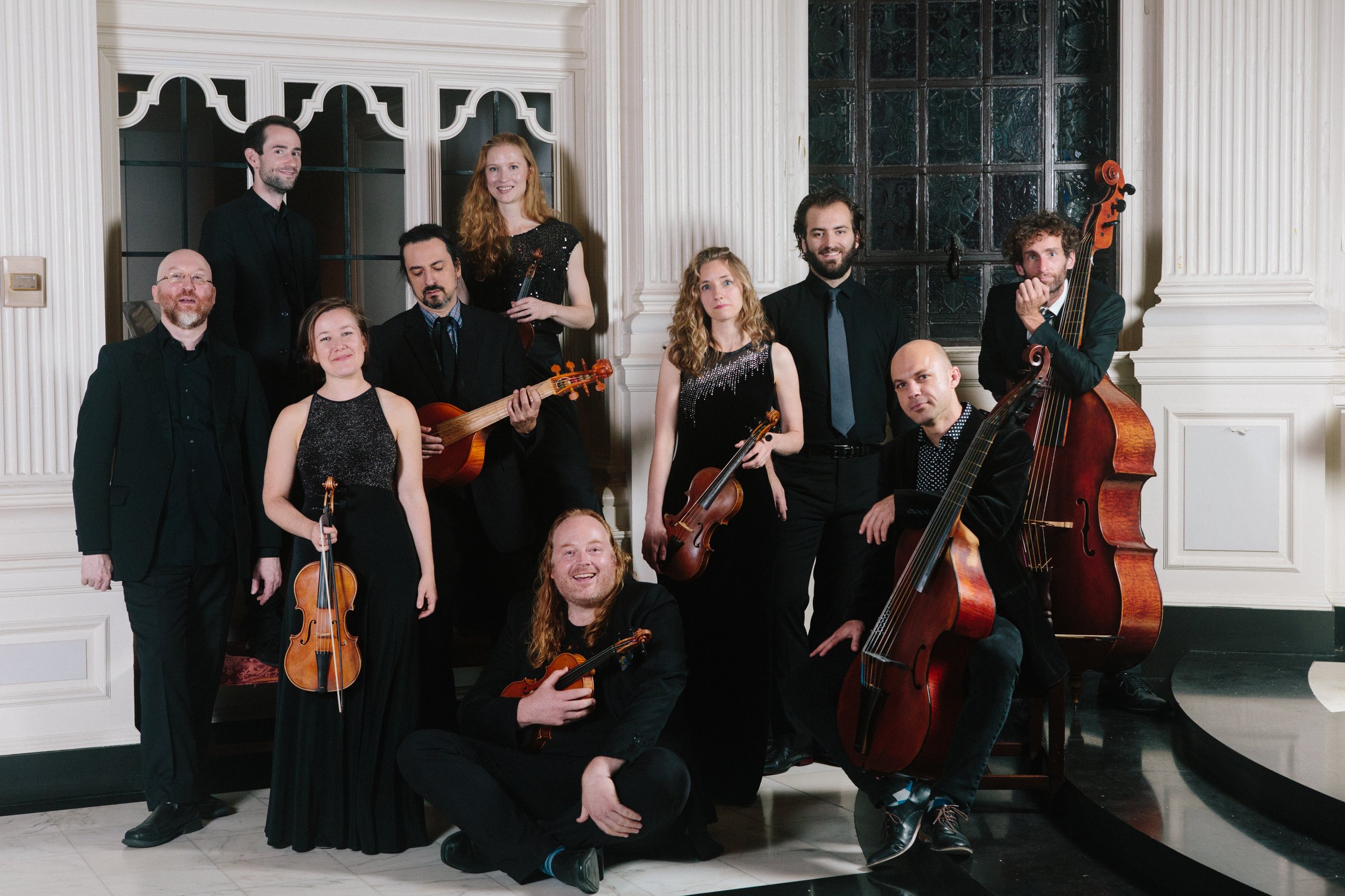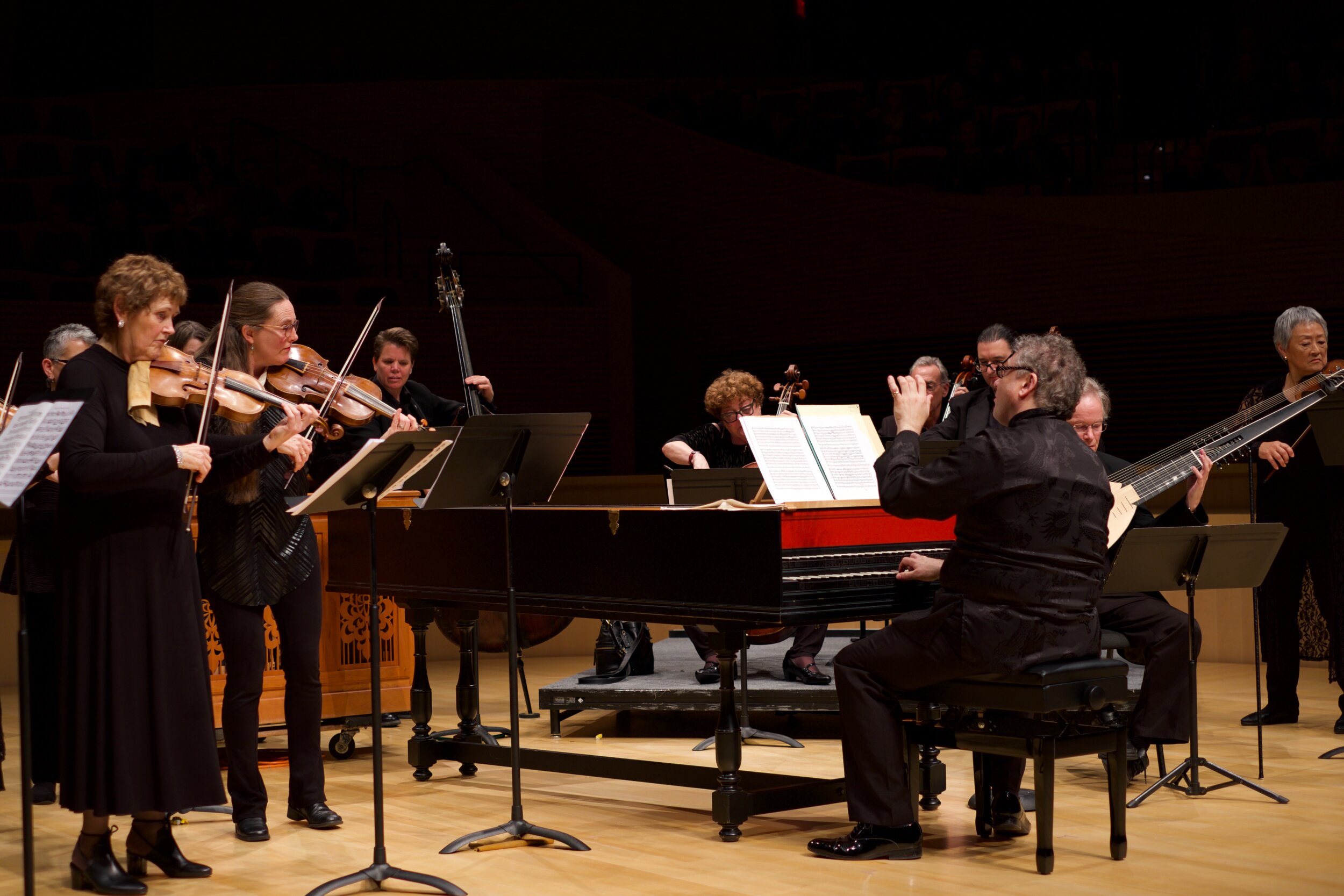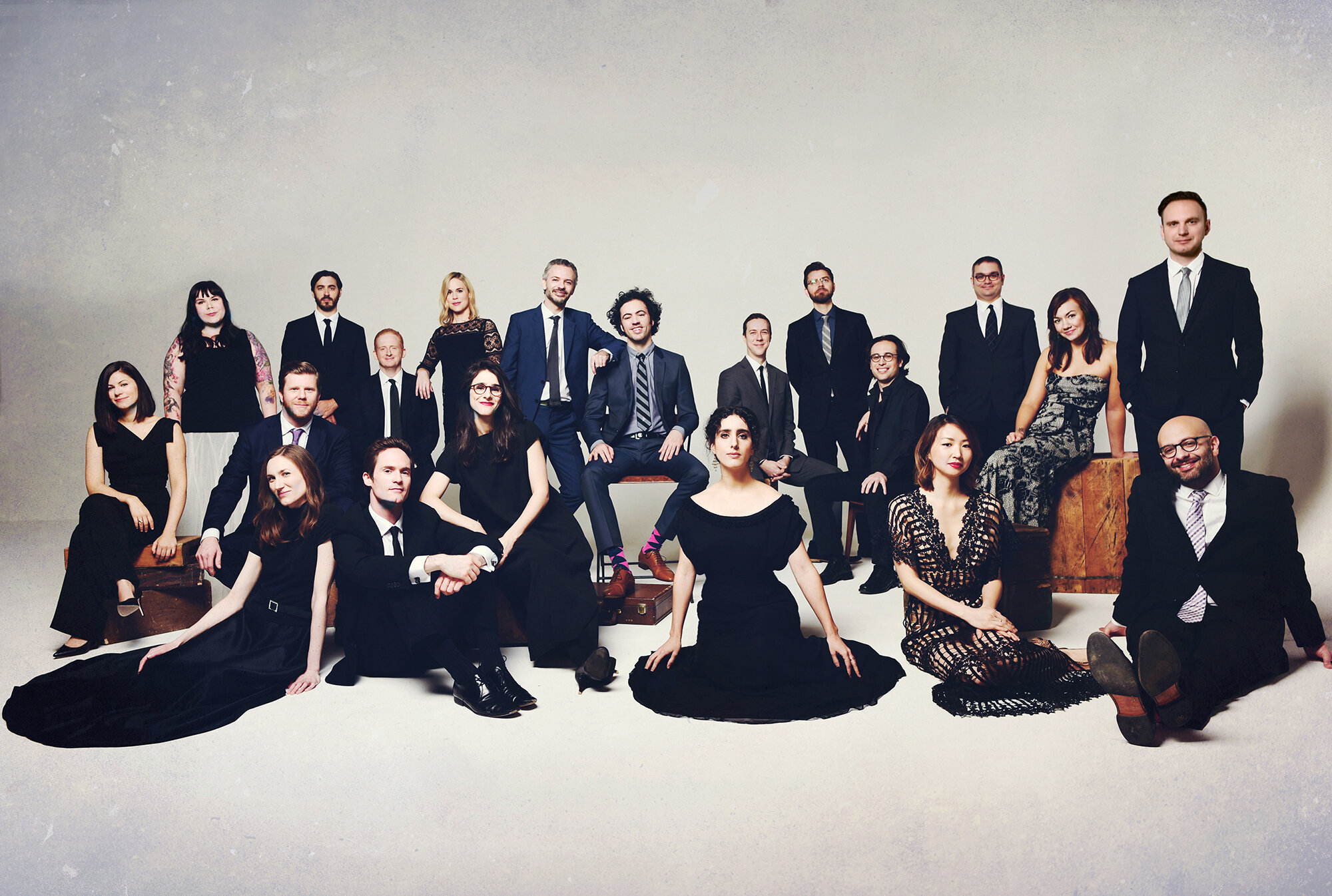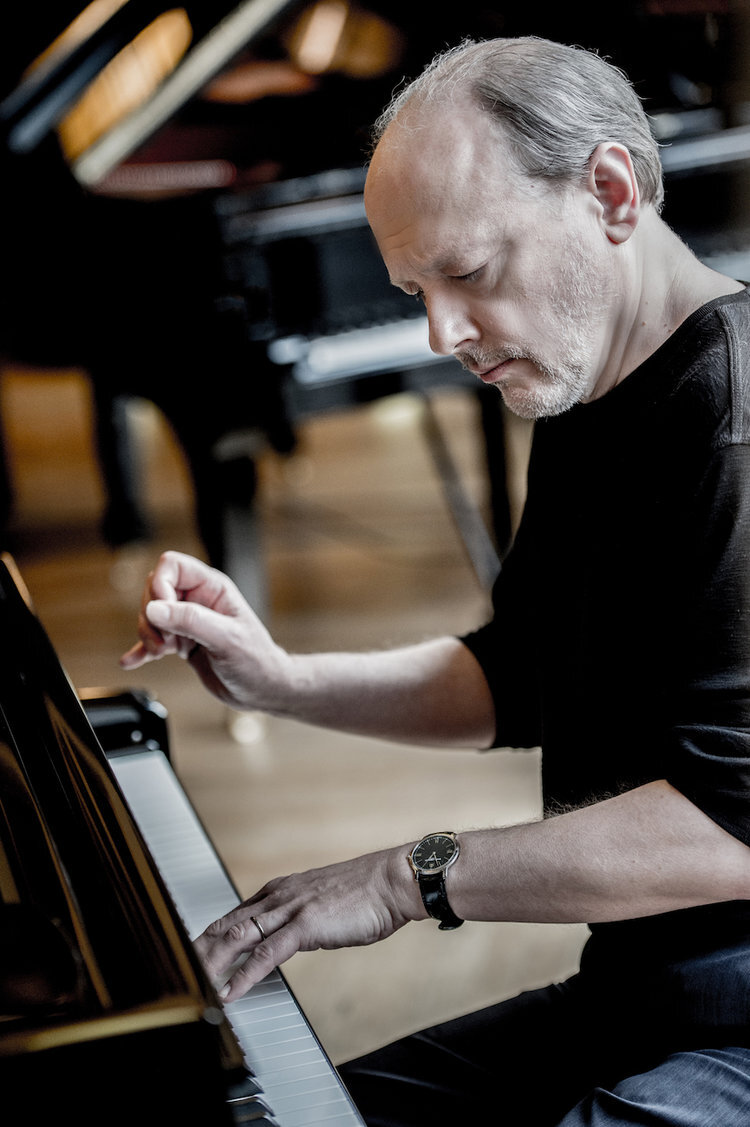JUNE 18, 2019 @ 7:00 PM
The Knights
Colin & Eric Jacobsen, Artistic Directors
Eric Jacobsen, conductor
Colin Jacobsen, (1978-), What is the Grass ?
Kristina Nicole Miller, narrator —
Benjamin Britten, (1913-76), Lachrymae, Op. 48a, (1950, orch.1976)
Nicholas Cords, viola —
Eric Jacobsen, (1982-) Letters from God
arr. Kyle Sanna/Colin Jacobsen, Kristina Nicole Miller, narrator —
Kyle Sanna, (1975-) Immense have been the Preparations
arr. Colin Jacobsen, Kristina Nicole Miller, narrator —
Lisa Bielawa, (1968-), Fictional Migration, (Solo Flute and Horn with strings)
(WORLD PREMIERE ARR.), Alex Sopp, flute Michael Atkinson, horn —
INTERMISSION
Felix Mendelssohn, (1809-47), String Octet, Op. 20, (1825)
Allegro moderato ma con fuoco (E-flat major)
Andante (C minor)
Scherzo: Allegro leggierissimo (G minor)
Presto (E-flat major) —
**The performance of The Knights has been made possible by a generous grant from the MacDonald-Peterson Foundation.**
WQXR HOST: Elliott Forrest
ADDITIONAL INFORMATION
PROGRAM NOTES
What is it then between us?
What is the count of the scores or hundreds of years between us?
— Walt Whitman, Crossing Brooklyn Ferry
Every year we look forward to the summer season, where music can live and breathe in open air and be shared freely with New Yorkers ranging from the lifelong classical music aficionado to those who just happen to be passing by. They hear the strains of Beethoven mingling with birds at dusk, blaring sirens and the general hum of the city, are drawn in and stop to experience a moment of unexpected contemplation amidst the swirl of it all… We thank Naumburg Orchestral Concerts for providing this “Whitmanic” service to New York since 1905, with The Knights participating now eleven years running. Though the ambience of Central Park will be missed, we are thrilled to make music in another NY landmark for the first time, Temple Emanu-El. Today we are celebrating two birthdays in which voices from the past reach across time and continue to resonate with us. One is a human being: Walt Whitman, the American bard whose 200th birthday is being observed this year. The other is an instrument: an Amati viola, four hundred years old, owned by our friend Richard Prins and generously loaned to Nicholas Cords, whose performance of Benjamin Britten’s Lachrymae will give its unique voice a special platform to sing for this occasion.
Whitman’s Song of Myself, radical for its time, composed in a time of great political polarization and divide leading up to the Civil War, is, in the words of Karin Coonrod (Director, Compagnia de’ Colombari) “a radical statement of interdependence.” Whitman’s relationship with music is well-documented, as he was a journalist and music critic familiar with the hymns, folk music and popular ballads of the day alongside Europe’s latest operas, oratorios, orchestra and chamber music. He credited music, and in particular opera, as being the source that unlocked his poetic inspiration, leading to the 1855 version of Leaves of Grass.
Eric Jacobsen, me, Knights flutist Alex Sopp, and frequent Knights guitarist/composer Kyle Sanna wrote music about 10 years ago for More Or Less I Am… a theatrical version of Whitman’s Song of Myself, created and conceived by Coonrod. Coonrod’s theater troupe Compagnia de’ Colombari recently remounted the piece in public spaces, parks and correctional facilities all over New York. We wanted to continue the celebration by expanding the orchestration of a few of these numbers for you tonight. We are grateful to Kristina Nicole Miller for being here to speak-sing Whitman’s words out loud.
Like many of the great composers of the past, English composer Benjamin Britten (1913-1976) was both a violist and a pianist. In the original version of his Lachrymae (written supposedly to induce the great Scottish violist William Primrose to come play with him at his nascent Aldeburgh Festival) he combined the two instruments. Britten was a master of theme and variations, which is the form this piece takes, though with an unusual twist. Instead of the theme being presented at the beginning in the usual manner and then the variations being elaborations, ornamentations and development of that theme; here the variations and development come first, time seems to take place in reverse and the theme is heard in its complete form only at the end as a solemn revelation. Britten was a great champion of music from England’s distant past, particularly the works of Henry Purcell (1659-1695) and lute master/composer John Dowland (1563-1626). It is the latter’s song, If My Complaint Could Passions Move that is revealed at the end of the piece and is the main material that Britten reflects upon, dissects, and uses to invent the series of variations. An additional Dowland song, Flow My Tears, also finds itself briefly quoted here and there. Some years after the premiere of Lachrymae by Primrose and Britten in Aldeburgh, he made the piece a concertante-like piece, orchestrating the piano part for strings. This is the version we’ll be doing tonight.
We love the idea of participating in a living tradition that is part of a continuum of invention: when something really old (Dowland’s music) is able to inspire someone closer to our time (Britten) to create something new. Similarly, the Amati viola leading the dialogue in Nicholas Cords’ hands was born in the time of Dowland and has been changed subtly through the years in order to suit modern players (smaller neck, tighter setup/tension), but the form and essence remains the same. And luckily there are a plethora of great modern instrument makers making small personal innovations on what is basically the same forms which the great old Italian makers created.
Composer Lisa Bielawa (b. 1968) has had a long-standing relationship with The Knights, creating a number of pieces and experiences which we hold dear in our memory. These include site-specific and audience immersive experiences such as Tempelhof Broadcast, which included around two hundred performers led by members of The Knights on the tarmac of the former Tempelhof airport; Chance Encounter, performed in Seward Park on the Lower East Side; and Tempelhof Etude, the concert piece that was the basis of the Tempelhof event. Lisa’s Fictional Migrations, like Britten’s Lachrymae, began its life as a chamber piece with piano that has since been orchestrated. Here are her notes on the original flute, horn and piano piece:
Flutist Alex Sopp and hornist Mike Atkinson have, through the work I’ve done with The Knights over the years, been partnering and inspiring my work for over a decade. It was time to honor them, and to join with The Knights in honoring them, by creating a version of Fictional Migrations for string orchestra and the two soloists. It is in effect a double concerto for two instruments that are seldom if ever featured together, but will always belong together in my mind because of these two remarkably gifted and adventurous players.
Commissioned by the Seattle Chamber Music Society in 2017, I composed Fictional Migrations (originally for flute/piccolo, horn, and piano) in observance of the 25th anniversary of Olivier Messiaen’s death. An ornithologist as well as a composer, Messiaen wove actual birdsongs into many of his works. I do so too in my piece, but – given my own ‘indoorsy’ orientation and lack of any authentic attachment to the birds in nature – they are made-up birds, ‘What if?’ birds, created in the spirit of speculative fiction. The six continuous sections of the piece bear subtitles to suggest possible bird embodiments to the players as they go. These birds exist in a world where prisoners fly out of captivity effortlessly, and we all magically transcend death and suffering.
Fictional Migrations invites you to exist in this world, just for a little while, together.
— Lisa Bielawa
A wunderkind of wunderkinds, Felix Mendelssohn (1809-1847) wrote his ebullient string octet at the tender age of 16. As many have noted, the synthesis of formal elements (counterpoint/melody/harmony all fully developed) and depth of expression make an argument for Mendelssohn as most precocious composer of the western classical canon. Part of this was made possible by the unique atmosphere of his household, with philosophers, musicians, artists, writers, mathematicians, scientists constantly coming in and out the door. Many of these were part of the incredible Enlightenment education that Mendelssohn and his gifted sister Fanny received. In particular, one poet, none other than Goethe, became a friend and mentor to the young Mendelssohn and affected him greatly. Fanny was quoted as saying that Felix drew direct inspiration from a stanza of the Walpurgis Night Dream from Goethe’s Faust in the Scherzo movement of the Octet.
“The flight of the clouds and the veil of mist / Are lit from above. / A breeze in the leaves, a wind in the reeds, / And all has vanished.”
In addition, Fanny revealed that, “To me alone he told this idea: the whole piece is to be played staccato and pianissimo, the tremolos coming in now and then, the trills passing away with quickness of lightning; everything new and strange, and at the same time most insinuating and pleasing, one feels so near the world of spirits, carried away in the air, half inclined to snatch up a broomstick and follow the aerial procession. At the end the first violin takes a flight with a feather-like lightness, and – all has vanished.”
There’s something emblematic about this piece for us, which formed a soundtrack to early Knights years spent in a living room. It was about as orchestral as we could get in that room, and the idea of many individual voices contributing to a whole still animates us. The piece represents a duality that we strive to embrace: a chamber music experience can be grand and larger than life, and conversely an orchestra can achieve the intimacy and immediacy of chamber music. To quote Whitman one more time, “these tend inward to me and I tend outward to them…”
— Program Notes by Colin Jacobsen
LISA BIELAWA
Composer-vocalist Lisa Bielawa is a 2009 Rome Prize winner in Musical Composition. She takes inspiration for her work from literary sources and close artistic collaborations. The New York Times describes her music as, “ruminative, pointillistic and harmonically slightly tart.” She is the recipient of the 2017 Music Award from the American Academy of Arts & Letters, and she received a 2018 Los Angeles Area Emmy nomination for her unprecedented, made-for-TV-and-online opera Vireo: The Spiritual Biography of a Witch’s Accuser. In 2019, Bielawa became the inaugural Composer-in-Residence and Chief Curator at the new Philip Glass Institute (PGI) at The New School’s Center of the Performing Arts. The PGI is a landmark partnership between The New School, the Philip Glass Ensemble (PGE), and Bielawa, who began touring as the vocalist with the Ensemble in 1992. In 1997, she co-founded the MATA Festival, which celebrates the work of young composers. Bielawa served as Artistic Director of the San Francisco Girls Chorus from 2013-2018 and recently completed her residency at Grand Central Art Center in Santa Ana, California. She was named a William Randolph Hearst Visiting Artist Fellow at the American Antiquarian Society for 2018. Her discography includes albums on the Tzadik, TROY, Innova, BMOP/sound, Orange Mountain Music and Sono Luminus labels. Bielawa’s music is frequently performed throughout the US and Europe, with recent and upcoming highlights including two world premieres at the 2016 NY PHIL BIENNIAL, Drama/Self Pitypremiered by the Orlando Philharmonic, performances as both composer and soloist at The Kennedy Center’s KC Jukebox series, SHIFT Festival, and with violinist Jennifer Koh at National Sawdust. Bielawa’s music can be found outside the concert hall as well: Chance Encounter was premiered by soprano Susan Narucki and The Knights in Lower Manhattan’s Seward Park; andAirfield Broadcasts, a 60-minute work for hundreds of musicians, was premiered on the tarmac of the former Tempelhof Airport in Berlin in May 2013 and at Crissy Field in San Francisco in October 2013. Bielawa’s Vireo was produced as part of Bielawa’s artist residency at Grand Central Art Center in Santa Ana, California and in partnership with KCETLink and Single Cel. The opera was filmed at locations across the country, and featured over 350 musicians in support of its core cast. Vireo was broadcast online and on TV by KCET. The Los Angeles Times called it an opera, “unlike any you have seen before, in content and in form,” and San Francisco Classical Voice described it as, “poetic and fantastical, visually stunning and relentlessly abstract.” In February 2019, Vireo was released as a two CD + DVD box set on Orange Mountain Music, featuring all of the music and episodes. It is coming to the stage as VIREO LIVE, a hybrid film-opera experience in 2020.
SOLOIST BIOS
KRISTINA NICOLE MILLER is a native of Akron, Ohio, and has lived in NYC since 2004. She has been performing since she was three years old, and attended performing arts schools from sixth grade and beyond, where she received classical and musical theatre training. She has performed in many productions both nationally and internationally. She’d like to thank her amazing boyfriend Chuck for being her sanity, and all of you here today for supporting live performance and making this work possible.
For more than two decades, omnivorous violist NICHOLAS CORDS has been on the front line of a growing constellation of projects as performer, educator, and cultural advocate. Nicholas currently serves as violist, Programming Chair, and Co-Artistic Director of the internationally renowned musical collective Silkroad. Founded by Yo-Yo Ma in 2000 with the belief that listening across cultures leads to a more hopeful world, Silkroad’s mission is explored world-wide through countless learning initiatives and a deep commitment to the exploration of new music and partnerships. Recent highlights include the Grammy Award winning album ‘Sing Me Home’ (Best World Music Album 2017), the Oscar-nominated documentary on Silkroad by Morgan Neville ‘The Music of Strangers,’ and music created for Ken Burns’ recent series ‘The Vietnam War.’ Another key aspect of Nicholas’ busy musical life is as founding member of Brooklyn Rider, an intrepid group which NPR credits with “recreating the 300-year-old form of the string quartet as a vital and creative 21st-century ensemble.” Brooklyn Rider’s singular mission and gripping performance style have resulted in an indelible contribution to the world of the string quartet that has brought in legions of fans across the spectrum. Recent collaborators include Irish fiddler Martin Hayes, Swedish mezzo soprano Anne Sofie von Otter, jazz saxophonist Joshua Redman, Persian kemancheh virtuoso Kayhan Kalhor, banjo legend Béla Fleck, and Mexican jazz singer Magos Herrera. A committed teacher, Nicholas joined the viola and chamber music faculty at New England Conservatory this past fall after teaching at Stony Brook University for the past seven years.
ALEX SOPP is a musician and artist living in Brooklyn. As the flutist of yMusic, The Knights, and NOW Ensemble, the New York Times has praised her playing as “exquisite” and “beautifully nuanced.” Most recently she has been a member of Paul Simon’s band for his Homeward Bound Tour, both singing and playing on stages worldwide. Comfortable in many genres, Alex has commissioned, premiered, and recorded with some of the most exciting composers and song writers of our time. She has appeared as a soloist with the NY Philharmonic and her paintings grace the covers of many records. Alex grew up in St. Croix, Virgin Islands, and trained at the Juilliard School.
MICHAEL P. ATKINSON is a NYC-based hornist, arranger/orchestrator and composer. In addition to performing as Solo hornist of The Knights, his credits as a performer include the New York Philharmonic, International Contemporary Ensemble, St. Paul Chamber Orchestra, American Symphony Orchestra, Orchestra of St. Luke’s, and Chamber Music Society of Lincoln Center. His orchestrations and arrangements have been performed in venues around the world by a wide range of ensembles including The Knights, A Far Cry, NYC Ballet, Orlando Philharmonic, Australian Chamber Orchestra, Vienna Opera Ballet, Dutch National Ballet, APM’s Live from Here with Chris Thile, and folk/Americana trio I’m With Her. In 2019, Michael’s piece “Ligeti Split” (after G. Ligeti’s Hungarian Rock) was premiered by The Knights in NYC at Zankel Hall.
The Grammy-nominated Knights are an orchestral collective, flexible in size and repertory, dedicated to transforming the concert experience. Engaging listeners and defying boundaries with programs that showcase the players’ roots in the classical tradition and passion for artistic discovery, The Knights have “become one of Brooklyn’s sterling cultural products… known far beyond the borough for their relaxed virtuosity and expansive repertory” (New Yorker).
The Knights have had an exciting 2017-18 season, a highlight of which was a U.S. tour with genre-defying Israeli mandolinist Avi Avital and Syrian clarinetist and composer Kinan Azmeh. Tour repertoire came from around the world, with arrangements and transcriptions by the artists themselves, and features the world premiere of Azmeh’s Triple Concerto for Clarinet, Mandolin, Violin and Orchestra. Thanks in part to the generous support of the Mellon Foundation, The Knights’ will complete their second Home Season in Brooklyn, in partnership with the downtown venue BRIC, presenting family concerts, evening performances, and a characteristically wide-ranging roster of guest artists. Programs include a collaboration with Puerto-Rican composer Angelica Negrón on her drag opera, a night of German lieder with Katja Herbers, as well as an exploration of the pervasive influence of Eastern European folk music. The Knights’ 2017 summer season encompassed a world premiere by composer Judd Greenstein and an East Coast premiere by Vijay Iyer; their tenth consecutive appearance in Central Park’s Naumburg Orchestral Concerts series; their fourth year at Tanglewood, a performance at the Ravinia Festival with mezzo-soprano Susan Graham; and a collaboration with choreographer John Heginbotham at the Jacob’s Pillow Dance Festival.
The 2016-17 season saw the release of the celestial-themed album Azul on Warner Classics with longtime collaborator Yo-Yo Ma; an EP release with Gabriel Kahane of his song cycle Crane Palimpsest; a debut at Washington DC’s Kennedy Center as part of the inaugural “SHIFT: A Festival of American Orchestras;” and the New York premiere of Sarah Kirkland Snider’s song cycle Unremembered, which The Knights also performed at Tennessee’s Big Ears Music Festival. They rounded out the season with a European tour, which took them to the Easter Festival at Aix-en-Provence for six performances with celebrated guest artists pianists Jean-Yves Thibaudet and Bertrand Chamayou, and violinist Renaud Capuçon; along with three concerts across Germany, including one at the new Elbphilharmonie in Hamburg where the ensemble’s performance was lauded as one of the best in the new hall (Hamburg Abendetter).
Counted among the highlights from recent seasons are: a performance with Yo-Yo Ma at Caramoor; the recording of Prokofiev’s Second Violin Concerto on master violinist Gil Shaham’s Grammy-nominated 2016 release, 1930’s Violin Concertos, Vol. 2, as well as a North American tour with Shaham; residencies at Dartmouth, Penn State and Washington DC’s Dumbarton Oaks; and a performance in the NY PHIL BIENNIAL along with the San Francisco Girls Chorus (led by composer Lisa Bielawa) and the Brooklyn Youth Chorus, which featured world premieres by Rome Prize-winner Bielawa, Pulitzer Prize-winner Aaron Jay Kernis, and Knights violinist and co-founder Colin Jacobsen. The ensemble made its Carnegie Hall debut in the New York premiere of the Steven Stucky/Jeremy Denk opera The Classical Style, and has toured the U.S. with banjo virtuoso Béla Fleck, and Europe with soprano Dawn Upshaw. In recent years The Knights have also collaborated with Itzhak Perlman, the Mark Morris Dance Group, Joshua Redman, Silk Road virtuoso Siamak Aghaei, and pipa virtuoso Wu Man. Recordings include 2015’s “instinctive and appealing” (The Times, UK) the ground beneath our feet on Warner Classics, featuring the ensemble’s first original group composition; an all-Beethoven disc on Sony Classical (their third project with the label); and 2012’s “smartly programmed” (NPR) A Second of Silence for Ancalagon.
The Knights evolved from late-night chamber music reading parties with friends at the home of violinist Colin Jacobsen and cellist Eric Jacobsen. The Jacobsen brothers, who are also founding members of the string quartet Brooklyn Rider, serve as artistic directors of The Knights, with Eric Jacobsen as conductor. In December 2012, the Jacobsens were selected from among the nation’s top visual, performing, media, and literary artists to receive a prestigious United States Artists Fellowship.
The Knights’ roster boasts remarkably diverse talents, including composers, arrangers, singer-songwriters, and improvisers, who bring a range of cultural influences to the group, from jazz and klezmer to pop and indie rock music. The unique camaraderie within the group retains the intimacy and spontaneity of chamber music in performance.
Colin Jacobsen, Artistic Director
As the Washington Post observes, violinist and composer Colin Jacobsen is “one of the most interesting figures on the classical music scene.” A founding member of two game-changing, audience-expanding ensembles – the string quartet Brooklyn Rider and orchestra The Knights – he is also a touring member of Yo-Yo Ma’s venerated Silk Road Project and an Avery Fisher Career Grant-winning violinist. Jacobsen’s work as a composer developed as a natural outgrowth of his chamber and orchestral collaborations. Jointly inspired by encounters with leading exponents of non-western traditions and by his own classical heritage, his most recent compositions for Brooklyn Rider include Three Miniatures – “vivacious, deftly drawn sketches” (New York Times) – which were written for the reopening of the Metropolitan Museum of Art’s Islamic art galleries. Jacobsen collaborated with Iran’s Siamak Aghaei to write a Persian folk-inflected composition, Ascending Bird, which he performed as soloist with the YouTube Symphony Orchestra at the Sydney Opera House, in a concert that was streamed live and seen by millions of viewers worldwide. His work for dance and theater includes Chalk and Soot, a collaboration with Dance Heginbotham, and music for Compagnia de’ Colombari’s theatrical production of Walt Whitman’s Song of Myself.
Eric Jacobsen, Artistic Director
Hailed by the New York Times as “an interpretive dynamo,” conductor and cellist Eric Jacobsen has built a reputation for engaging audiences with innovative and collaborative projects. Jacobsen is the founder and Artistic Director of The Knights and a former member of the genre-defying string quartet Brooklyn Rider. As conductor of The Knights, Jacobsen has led the “consistently inventive, infectiously engaged indie ensemble” (New York Times) at New York venues ranging from Carnegie Hall to Central Park, and at renowned international halls such as the Vienna Musikverein, Cologne Philharmonie and the Elbphilharmonie. In 2017-18, Jacobsen is set to embark on his third season as Music Director of the Orlando Philharmonic. Also in demand as a guest conductor, Jacobsen has recently led the Camerata Bern, the Detroit Symphony, the Alabama Symphony, ProMusica Chamber Orchestra, Deutsche Philharmonie Merck, and Yo-Yo Ma’s Silk Road Ensemble.























